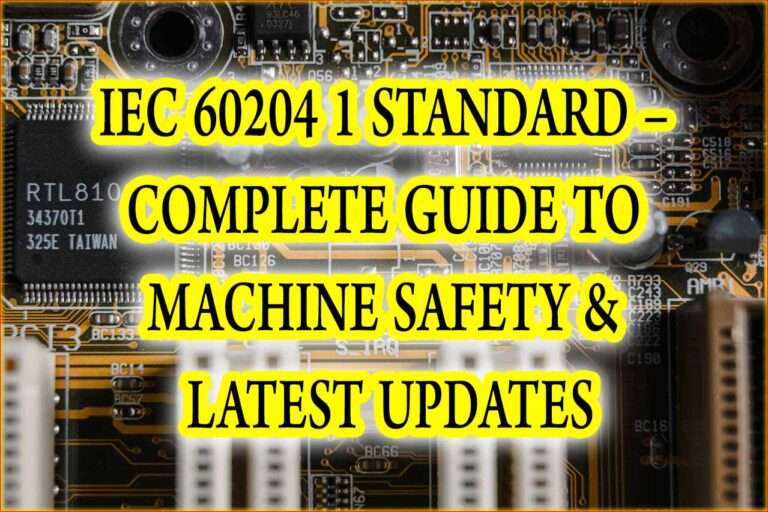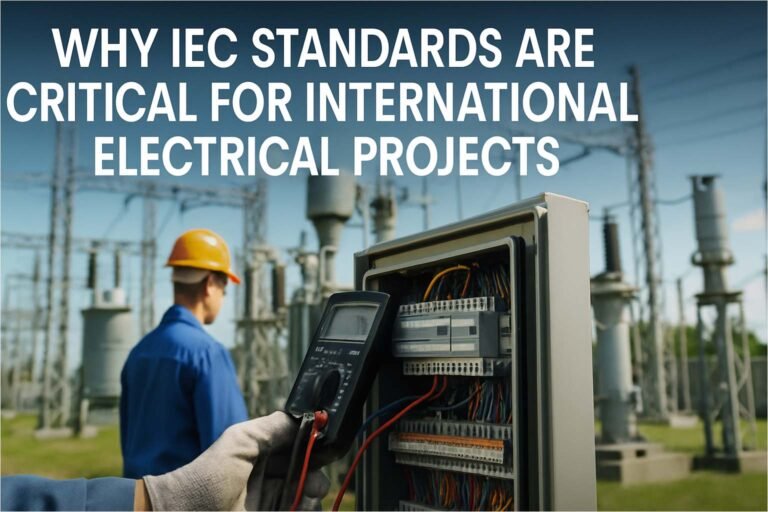IEC 61508 vs ISO 13849: Key Differences, Safety Levels & Compliance Guide
Understanding functional safety standards is essential for modern industrial systems. Engineers, manufacturers, and automation professionals often compare IEC 61508 vs ISO 13849 when deciding which standard to apply. Both standards focus on reducing risks in machinery and control systems, but they differ in structure, terminology, and application areas.
This detailed guide explains every important difference in simple language. It also covers design principles, system requirements, and use-case recommendations. The goal is to help you choose the right standard for your project with clarity and confidence.

Table of Contents
What Is the Core Difference in IEC 61508 vs ISO 13849
The debate between IEC 61508 vs ISO 13849 has grown over the years because industries need clear guidelines. IEC 61508 is a broad functional safety standard for electrical, electronic, and programmable electronic systems. It applies across many sectors including process plants, oil and gas facilities, transport systems, and automation. ISO 13849 focuses mainly on machinery safety and covers safety-related parts of control systems. Learn more about earthing cable size as per iec
It is derived from EN 954-1 but offers more advanced performance-based requirements. IEC 61508 is system-oriented, while ISO 13849 is more component-oriented. IEC 61508 introduces SIL levels. ISO 13849 introduces Performance Levels. Both aim to reduce the probability of dangerous failures, but their methods differ.
Why Comparing IEC 61508 vs ISO 13849 Matters for Engineers
Modern machinery and automated systems require strong safety controls. Engineers must design systems that detect faults, stop failures, and protect human operators. Many plants still consider whether IEC 61508 or ISO 13849 is ideal for their risk level. Making the right decision reduces future engineering cost, certification effort, and compliance issues.
Understanding IEC 61508 vs ISO 13849 also helps when selecting PLCs, sensors, relays, and safety modules. Choosing the wrong standard can lead to over-engineering or under-design. This article provides real insight into both documents so you can match them to your safety goals. Discover everything about cable bending radius iec standard
Structural Comparison of IEC 61508 vs ISO 13849
The two standards differ in structure and method. IEC 61508 uses SIL classification from SIL 1 to SIL 4. ISO 13849 uses PL classification from PL a to PL e. Below is a comparison table for quick understanding.
Table: Difference between SIL and PL
| Feature | IEC 61508 (SIL) | ISO 13849 (PL) |
|---|---|---|
| Classification | SIL 1 to SIL 4 | PL a to PL e |
| Approach | Probabilistic, system based | Hybrid quantitative and qualitative |
| Risk Graph | Yes | Yes |
| Diagnostic Coverage | Detailed, strict | Moderate to high |
| Hardware Fault Tolerance | Required | Considered but flexible |
| Software Requirements | Extensive | Medium level |
| Industry Usage | Cross-industry | Machinery and automation |
This table helps engineers quickly compare IEC 61508 vs ISO 13849 requirements. SIL classification is more rigorous and requires deeper documentation. PL classification is simpler and easier for machine builders with limited engineering resources. Explore details on iec 61508 functional safety
Detailed Explanation of IEC 61508 in the Context of IEC 61508 vs ISO 13849
IEC 61508 is known as the mother of all functional safety standards. It influences many sector-specific standards, including IEC 61511 for process safety and IEC 62061 for machinery safety. It introduces the safety lifecycle, a step-by-step model that guides project teams from concept to decommissioning. It covers hardware and software failures, system architecture, probability of failure on demand, and diagnostic methods. The standard focuses on functional safety integrity. Understand better about nec 430.32
This makes it ideal for complex systems such as chemical plants, railways, nuclear instrumentation, and automated industrial controls. The standard requires proven-in-use data, fault analysis, and strong software development techniques. When comparing IEC 61508 vs ISO 13849, engineers often find that IEC 61508 is more demanding. It is also better suited for high-risk environments.
Detailed Explanation of ISO 13849 in the Context of IEC 61508 vs ISO 13849
ISO 13849 is designed for machinery manufacturers. It simplifies the implementation process without compromising safety. It focuses on safety-related control system parts, including safety relays, emergency stops, interlock switches, and light curtains. The PL rating helps determine how robust the safety function should be. Dive deeper into instrument earthing iec standard
The calculation of performance levels includes Mean Time To Dangerous Failure, Diagnostic Coverage, and Common Cause Failure. ISO 13849 is easier to apply in small and medium factories. It does not require the extensive documentation required by IEC 61508. When comparing IEC 61508 vs ISO 13849, ISO 13849 is usually the faster option for machine builders.
Practical Use Cases to Understand IEC 61508 vs ISO 13849
Many companies struggle to choose between these two standards. The selection usually depends on system complexity, required reliability, documentation ability, and certification needs. For example, a packaging machine with basic safety functions may only require ISO 13849. A chemical reactor emergency shutdown system may need IEC 61508 because the risks are higher. Know more about iec 61508
A point to remember in the debate of IEC 61508 vs ISO 13849 is that both can be used in certain overlapping scenarios, but they offer different confidence levels. Machine builders can even use ISO 13849 for hardware design and IEC 61508 for software development. Real-world examples below help illustrate the difference.
Use Case Examples:
A conveyor belt machine
Most systems use ISO 13849 because speed sensing and emergency stops do not require SIL-level control.
A fire and gas detection system
This usually requires IEC 61508 because missing a detection could lead to catastrophic failure.
A simple material handling machine
ISO 13849 is usually enough due to lower risk levels.
A reactor shutdown system
IEC 61508 is the preferred choice because SIL 3 or SIL 4 functions may be required.
These examples highlight how IEC 61508 vs ISO 13849 differ in scope and safety depth. Dive deeper into complete guide to iec 61508
Design Methodology Differences in IEC 61508 vs ISO 13849
IEC 61508 uses a complete safety lifecycle approach. It focuses on hazard analysis, failure probability, verification, and validation. It also includes competency requirements and management of change. ISO 13849 is more focused on component performance. It uses category architecture and PL calculations to determine reliability.
The system design philosophy diverges significantly. IEC 61508 expects systematic capability control. ISO 13849 focuses on structural resistance and diagnostic coverage. When comparing IEC 61508 vs ISO 13849, SIL design forces deeper quantitative analysis. PL design supports simpler machines with moderate risk. Uncover insights on iec standard for lighting lux level
Interpretation of Failure Probability in IEC 61508 vs ISO 13849
IEC 61508 defines probability of failure on demand. Lower SIL levels allow higher failure rates. Higher SIL levels require extremely low failure rates. ISO 13849 defines average probability of dangerous failure per hour. The calculation method is different and less strict. Here is a simple comparison table.
Probability Comparison Table
| Level | IEC 61508 PFD range | ISO 13849 PFHd range |
|---|---|---|
| Low level | SIL 1 | PL a |
| Medium level | SIL 2 | PL c |
| High level | SIL 3 | PL d / e |
| Very high | SIL 4 | Not covered |
This table helps engineers understand the performance difference in IEC 61508 vs ISO 13849.
Certification Requirements in IEC 61508 vs ISO 13849
IEC 61508 certification is rigorous. It often includes audits, design documents, reliability analysis, and testing. ISO 13849 certification is easier and usually self-approved through PL calculations. Machine builders prefer ISO 13849 because it reduces cost and time. High-risk industries prefer IEC 61508 for stronger assurance.
Get complete information about iec standard for busbar sizing
Certification bodies also consider the safety lifecycle in IEC 61508. In ISO 13849, they mainly check component reliability and design method. This is another strong difference when comparing IEC 61508 vs ISO 13849.
Which Standard Should You Use in IEC 61508 vs ISO 13849
Choosing the right standard depends on the system type. If your system has electronic complexity, severe industrial hazards, or high failure consequences, IEC 61508 is recommended. If your system is mechanical in nature and only needs control-level safety, ISO 13849 is enough. Read in detail about iec 61439 busbar calculation
Many machine builders start with ISO 13849 due to simplicity. Many industrial plants adopt IEC 61508 for mission-critical systems. Understanding the scope of your system is essential before making a choice. The comparison of IEC 61508 vs ISO 13849 must consider cost, capability, and risk level.
Conclusion
The comparison of IEC 61508 vs ISO 13849 is essential for engineers working on safety systems. Both aim to reduce risks, but their structure, requirements, and design approaches differ. IEC 61508 is more advanced, lifecycle-based, and suited for high-risk environments. ISO 13849 is simpler, accessible, and ideal for general machine safety.
Understanding these differences helps engineers design safer, compliant, and more reliable systems. Choosing the right standard saves cost, improves safety, and supports long-term operational reliability. Explore details on iec standard for underground cable laying
Follow Us on Social:
Subscribe our Newsletter on Electrical Insights to get the latest updates in Electrical Engineering.
#IEC61508, #ISO13849, #IEC61508vsISO13849, #FunctionalSafety, #SafetyStandards, #MachineSafety, #IndustrialSafety, #SILCertification, #PLRating, #RiskAssessment, #SafetyEngineering, #AutomationSafety, #SafetyCompliance, #EngineeringStandards, #SafetyIntegrityLevel





